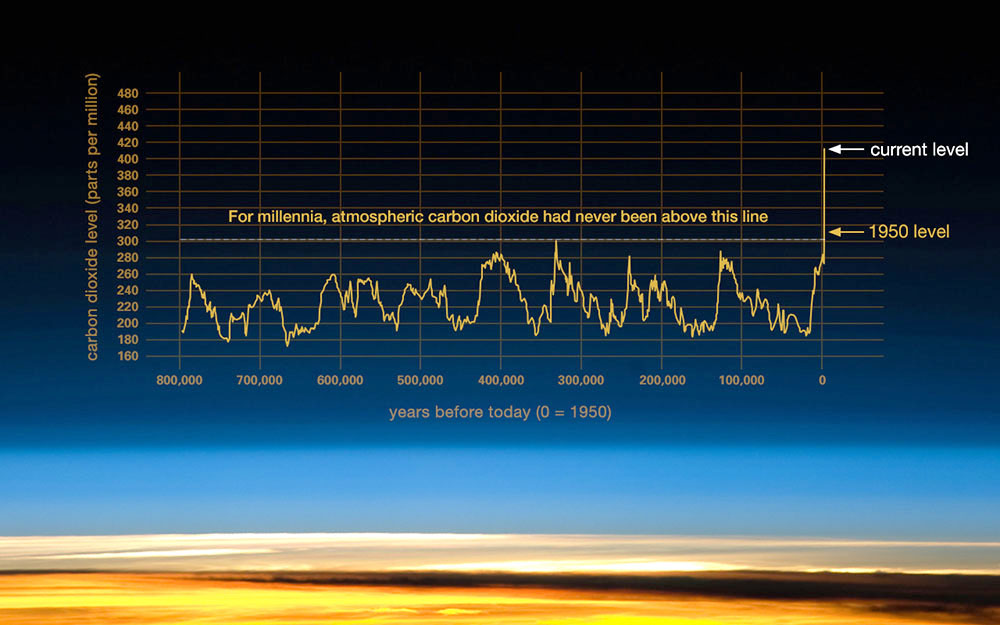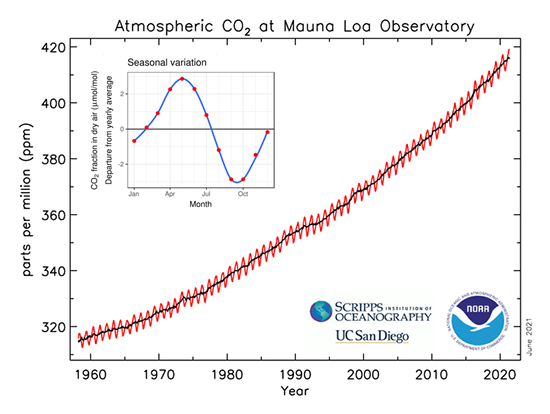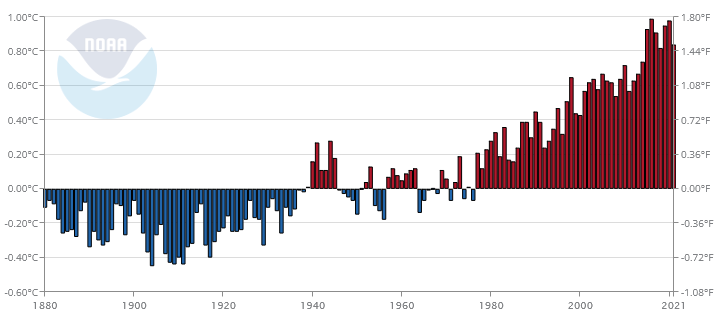Key Concepts
The rise in the surface temperature of the Earth. Global warming is one of the names given to the systematic increase of globally averaged surface temperature that has been measured since the mid-nineteenth century. There is abundant evidence that this particular episode of temperature increase is far more rapid than anything experienced on Earth in at least the last 800,000 years. This fact, coupled with analysis of trends in the atmospheric composition, underlies the consensus view among atmospheric scientists that the current temperature rise is a direct consequence of human activity. See also: Atmosphere
Global climate change
It is well known that the Earth’s climate changes dramatically both locally and globally over long periods of time. Much of this change is a function of regular, long-period oscillations in the characteristics of the Earth’s orbit around the Sun. The obliquity, or axial tilt, of the Earth varies between 22.1° and 24.4° every 41,000 years. The eccentricity of the orbit, which measures how far from perfectly circular the orbit is and therefore affects the actual distance the Earth is from the Sun, varies on a time scale of about 100,000 years. Precession measures the trend in the orientation of the Earth’s axis relative to the fixed stars, which also affects the intensity of solar radiation absorbed at the Earth’s surface. These and other naturally occurring astronomical cycles are known collectively as Milankovitch cycles, after the Serbian geophysicist and astronomer Milutin Milanković, who first proposed their influence on climate in the 1920s. Their combined influence on the Earth’s climate is clear in the time series of average temperature reconstructed from chemical analysis of air bubbles trapped in ancient ice from cores taken in Antarctica (Fig. 1). See also: Antarctica; Earth rotation and orbital motion; Paleoclimatology; Precession of equinoxes

As evidence continues to mount, it is becoming increasingly clear that substantial changes to the chemical composition of the Earth’s atmosphere through the by-products of industrialization are an equally potent forcing for much more rapid changes in the global climate. Earth’s atmosphere is a thin gaseous mixture of chemicals, each with different properties with respect to electromagnetic radiation. Most of the dozens of gases that constitute the mixture are transparent to visible light, which constitutes 44% of the Sun’s total emission of energy. The energy contained in this radiation is absorbed upon striking the surface (solid or liquid) of the Earth, forcing an increase in the surface temperature. This temperature increase induces emission of longer-wavelength, infrared (IR) radiation from the surface. See also: Atmospheric chemistry; Electromagnetic radiation; Global climate change; Heat balance of the Earth; Insolation; Solar radiation; Terrestrial radiation
Greenhouse gases
Certain gases in the atmospheric mixture, while transparent to the incoming visible light, are not nearly so transparent to the outgoing IR. Such gases, therefore, absorb IR energy during its attempt to escape to space. Absorption of this IR warms the atmosphere, which then emits more IR energy in every conceivable direction. Because half of those directions point downward, one-half of the emitted energy is directed toward the surface, where it is reabsorbed by the surface and thus results in an additional increase in the surface temperature. Gases such as carbon dioxide (CO2), methane (CH4), nitrous oxide (NO2), and water vapor (H2O; invisible water gas) are the most effective at such absorption and re-radiation of IR in our atmosphere. Their presence, though only fractional, is sufficient to absorb and re-radiate to the surface enough IR energy to render the Earth’s average surface temperature 15°C (59°F). By contrast, were the Earth just a bald rock in space 93 million miles away from the Sun, it would have an average surface temperature of only −18°C (0°F). In other words, the presence of these various gases renders Earth a habitable planet, because the actual average temperature crosses the threshold required for liquid water to exist and without liquid water there is most likely no viable pathway to the development of life. See also: Atmospheric water vapor; Carbon dioxide; Methane; Nitrogen oxides
These several gases are known colloquially as greenhouse gases because their presence in Earth’s atmosphere effectively keeps the planet warmer than would be expected given its distance from the solar heat source. The amounts of the various greenhouse gases in the Earth’s atmosphere can change, and such changes exert a substantial control on the global average temperature. Concerned that industrialization was changing the chemical composition of the Earth’s atmosphere more rapidly than more natural processes might, Swedish chemist Svante Arrhenius proposed in 1896 that fluctuations in CO2 concentrations could be a major influence on global average temperature. This notion struggled for decades to gain acceptance in the scientific community. More than 40 years later (1938), English engineer Guy Callendar presented evidence that both CO2 concentration and temperature had been increasing for the last 50 years. His insights were also largely ignored. Prompted by a growing body of work on the subject, by the late 1950s a compelling basis for the idea began to emerge. In 1965, U.S. President Lyndon Johnson’s Science Advisory Committee warned of the dangers posed by fossil fuel emissions, arguing that “an increase in atmospheric carbon dioxide could act, much like the glass in a greenhouse, to raise the temperature of the. . . air.” Not until British meteorologist John Sawyer published a paper in Nature (1972) was the importance of anthropogenic CO2 increase finally fixed in the international scientific firmament. Direct measurements of CO2 content were started by Charles Keeling at the top of Mt. Kilewaia in Hawaii in 1957. The now 62-year time series (Fig. 2) testifies robustly to the rapid increase in atmospheric CO2 concentration, which currently stands at 414.66 ppm (parts per million), a roughly 33% increase since 1957 (when it was near 315 ppm) and a level that has not been reached in at least the last 800,000 years. See also: Greenhouse effect

Recent warming
Abundant ancillary evidence of global warming has accrued in the past 30 or so years. Among the more compelling pieces are the analysis by J. J. Magnusson and coworkers (1995), which examined the length of the ice season on a collection of 38 widely distributed Northern Hemisphere lakes with long records of ice duration. Since 1845, the ice season on those lakes has shrunk, on average, by about 18 days, which represents well more than 10% of the season in nearly each case. J. E. Martin (2015) has examined the areal extent of lower-tropospheric cold air over the high latitudes of the Northern Hemisphere winter stretching back nearly 70 years and found that the wintertime polar “cold pool” has been systematically shrinking over that period (Fig. 3). The global average surface temperature record suggest an increase of about 1°C (1.8°F) since 1900, further testifying to the warming (Fig. 4).







